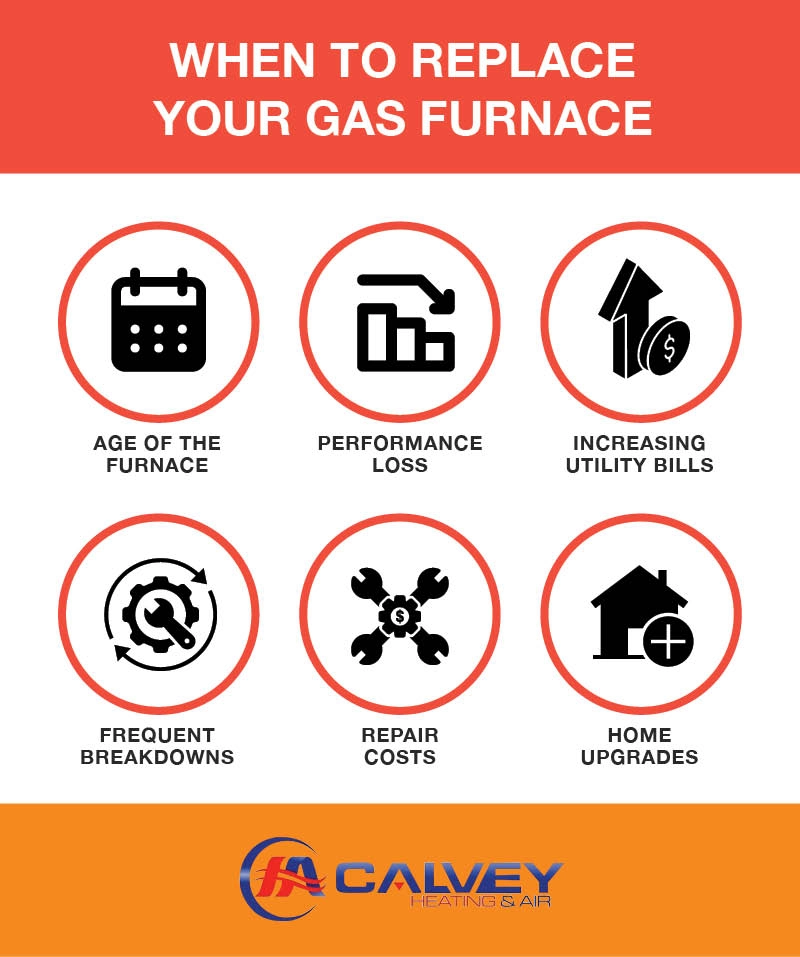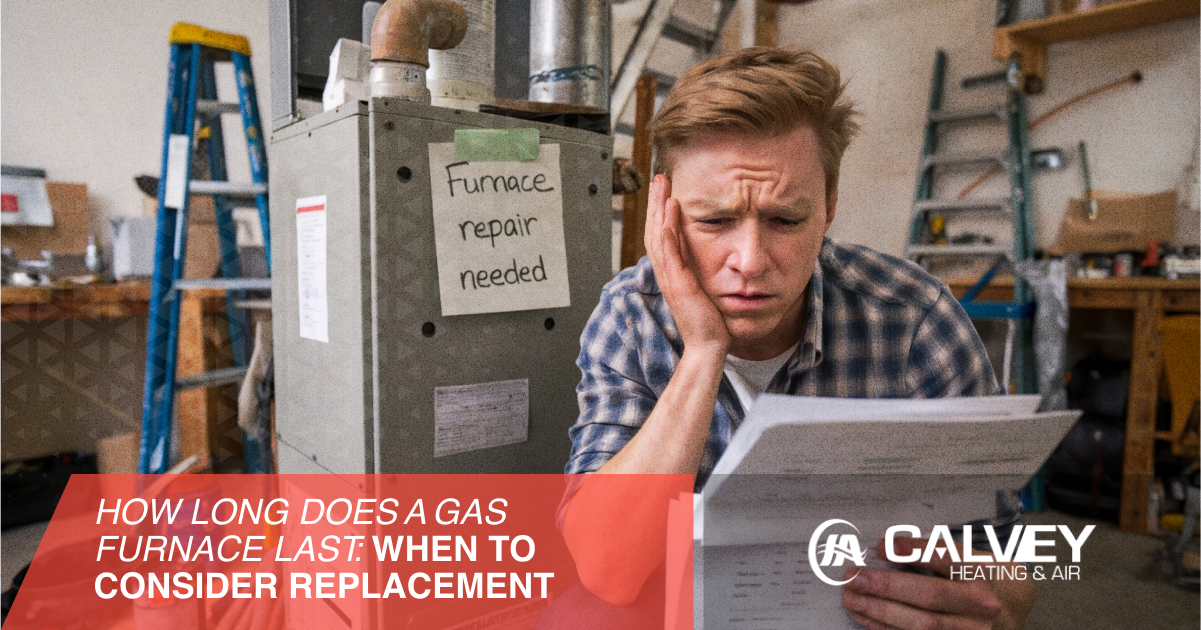Furnaces can seemingly go forever — until they don’t. Not sure how long your gas furnace may last? Understanding the factors influencing the average lifespan of a gas furnace helps you plan for replacement before you’re faced with urgent heating needs, saving you on costs and stress. Calvey Heating and Air is ready to assist with your furnace replacements, repairs, and more.
Average Lifespan of a Gas Furnace
On average, a well-maintained gas furnace lasts between 15 and 30 years. While uncommon, some units may last 40 years or more. Wear and tear gradually cause furnaces to work harder as they age, and efficiency may be limited even if they do last longer than average.
Regular maintenance is key — routine furnace tune-ups help strengthen your furnace’s longevity, optimizing reliability, efficiency, and costs over its lifespan.

Factors That Affect the Lifespan of a Gas Furnace
Although most furnaces generally last 15 years or longer, certain variables influence actual lifespans.
Maintenance
Maintenance keeps your furnace at optimal function. Neglecting maintenance leads to damaged heat exchangers, faulty burners, dirty sensors, loose components, and other wear. Over time, this wear may accumulate and cause issues that compromise the efficiency, function, and lifespan of your furnace.
Efficiency rating
Not all furnaces are created equally. Equipped with advanced technology and high-quality parts, high-efficiency furnace models don’t have to work as hard as a lower-efficiency model to provide your home with the same level of heating. This often translates to less wear on components, providing potentially superior durability and longevity.
Furnace brand
Furnaces with low upfront prices may seem most cost-effective, but they might have less durability than a more expensive model. Many top brands offer a range of models at various price points, with higher-end furnaces usually featuring premium parts and more robust warranty offerings. In other words, a furnace with higher upfront expense may perform better and last longer than a lower-end model, offering lower costs over its lifetime.
Proper sizing
The right furnace size for your home depends on its square footage, layout, insulation, and numerous other factors. Weighed together, these factors indicate your home’s overall heating load. A correctly sized furnace aligns with this heating load and operates with ideal efficiency.
In contrast, an oversized furnace doesn’t necessarily equate to more powerful heating, and an undersized furnace doesn’t save on costs. An oversized unit will cycle quickly and excessively, leading to greater wear, damage, and likelihood of premature failure. Likewise, an undersized unit must strain to heat your home and may work continuously, causing similar wear and increased chance of early replacement.
Installation
Without a qualified HVAC technician, furnace installation can go wrong in several ways and limit its potential lifespan. Examples include:
- Ductwork: Poorly designed, sealed, or sized ductwork leads to heat loss and more strain on your system.
- Exhaust: Without proper exhaust ventilation, your furnace system faces greater risk of damage. It also poses a risk of carbon monoxide leaks as a serious safety hazard.
- Drainage: A proper drainage system protects your furnace from water damage and efficiency loss.
- Thermostat placement: Installing a thermostat in areas exposed to direct sunlight, drafts, or heat sources causes inaccurate temperature readings that hurt furnace efficiency.
Usage
Homes in San Jose, Sunnyvale, and other relatively warm climates may see longer furnace lifespans since they’re not combating extreme winter cold. Programming your thermostat at a reasonable temperature, between 68 and 70 degrees, prevents excessive strain on your system without compromising comfort. Keeping your thermostat too high or low can make your system cycle constantly or more frequently.
Signs Your Old Gas Furnace May Need Replacement
As your furnace ages, certain symptoms may indicate need for repair or replacement. These include:
- Uneven or insufficient heating
- High utility bills
- Discolored or faulty pilot light
- Loud noises
- Frequent or constant cycling
- Strange smells
How Long Do Home Furnaces Last with Regular Maintenance?
Maintenance often makes the biggest difference in a furnace’s lifespan. Routine tune-ups, usually at least once per year before heating season, allow technicians to spot potential problems before they escalate. By preventing major problems and keeping your heating system clean and running smoothly, maintenance minimizes wear and improves overall longevity. Regular maintenance also offers other benefits, including reduced energy consumption and bills, better heating performance, fewer repair costs, improved air quality, and safety assurance.
Professional furnace maintenance starts with a thorough inspection, followed by cleaning the flue pipes, blower, sensors, and other areas with buildup and tightening or adjusting connections and other parts. Technicians also verify proper function of the heat exchanger, fuel line, pilot light, and other components.
In addition to scheduling routine maintenance, consider these practices between professional visits:
- Filter replacement: Depending on your home, filters require replacement at least every three months to avoid clogging and strain.
- Insulation: Upgrading or repairing your home’s insulation prevents heat loss.
- Airflow: Keep vents open and unobstructed. Seal small ductwork leaks with specialized tape.
- Visual inspections: Periodically check your system for signs of wear or potential problems.
When to Replace Your Gas Furnace
HVAC technicians can repair gas furnaces in most cases and keep them heating effectively. When your furnace starts to show these signs, however, start planning for replacement:
- Age of the furnace: An older furnace may be approaching the end of its lifespan and less cost-effective to repair.
- Performance loss: Your furnace may be due for replacement if it noticeably struggles to match heating needs.
- Increasing utility bills: Inexplicably high utility bills signal efficiency losses.
- Frequent breakdowns: Frequent breakdowns indicate increasing wear on your furnace and render it unreliable during peak heating season.
- Repair costs: Whether numerous small repairs, major breakdowns, or a mix of problems, repair costs may sometimes outweigh the cost of replacement.
- Home upgrades: Past or current renovations or additions may require a gas furnace upgrade to meet the altered heating demands of your home.
Call Calvey for Gas Furnace Replacement in San Jose
Protect your home from unexpected breakdowns, costly repairs, and premature furnace replacement. At Calvey Heating and Air, our team is committed to ensuring safe and comfortable heating in your home. Serving customers from Dublin to Sunnyvale, our HVAC team delivers high-quality workmanship and guaranteed customer satisfaction — schedule furnace replacement with Calvey Heating and Air.
Frequently Asked Questions
What factors should I consider when choosing a new furnace?
Look for furnaces with high annual fuel utilization (AFUE) ratings to get optimal efficiency from your new system. Ensure it’s properly sized for your home, and consider zoning control, manufacturer warranties, and other features.
Can I replace my furnace myself?
While some homeowners may feel capable of a DIY furnace replacement, this job is best left to pros. In addition to satisfying local building codes and permit requirements, an HVAC technician is essential for ensuring safe and precise installation.
How do I compare efficiency between furnace models?
Check the AFUE ratings provided by manufacturers, usually found on the yellow Energy Guide label. Higher ratings indicate high efficiency that can help lower utility bills and extend your furnace’s lifespan.
How much does a new furnace cost?
Your home’s heating load and required furnace power are the main determinants of the overall replacement cost. The cost of a new furnace also depends on several other factors, such as the brand, energy efficiency, extended warranties, existing ductwork, and more.


